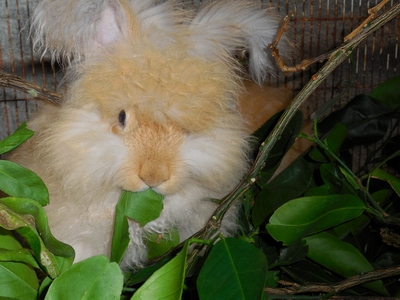The bunnies here at Hillside Farm Hawaii are technically livestock, but don't tell them that. Other than being offended, no doubt, they'd probably not believe you anyway. As 'livestock' they are almost like 'micro-sheep'. They like to live in a herd and will happily turn ti leaves, grasses, mulberry leaves and other tasty rabbit foods into some insanely soft fiber. Each of our little 'micro-sheep' makes about a pound of fiber per year. Considering they only weigh five to six pounds, that means they produce their body weight in fiber every five to six years. Busy little bunnies, indeed!
Hmm, how do these 'micro-sheep' compare to their larger full sized sheepy 'cousins'? There's tons of different breeds of sheep. And, each breed has a different quality of fleece, so when the label says 'wool' that's about as informative as if the label were to say 'food' when looking at a list of ingredients. Personally, I think fiber labels should say something along the line of 'fine Merino from a young ram' but that's not gonna happen when labels are made on an industrial scale. I think everyone should know their fiber providers, how can you properly knit or crochet with just any fiber? Here at Hillside Farm Hawaii we believe everyone should get to know their fiber providers! Well, anyway obviously, I got sidetracked. Ooops!
Okay, back to comparing fluffy buns to sheepies. So, looking up on the internet we can compare angora bunnies to Merino sheep since Merinos have some of the finest fleece produced by any of the sheep breeds. That will make things more accurate since they both produce fine fibers. (Not all sheep produce fine fibers or even any fleece at all - kinda like the assorted rabbit breeds, come to think on it.) So, the average weight of a Merino sheep is - I'll go look it up... Oh my, that's not as easy of a question as I'd expected. Apparently, there's even a variety of different breeds of Merino. Well, the University of Oklahoma has a listing for Delanie Merino Sheep. According to the University of Oklahoma, who seem like credible folks, the average weight of a Delanie Merino sheep is "Mature ewes with full fleece average from 125 to 180 pounds. Rams are larger ranging in weight from 175 to 235 pounds. Greater size can be achieved, but is not sought after because it often leads to the production of rangy, long-legged individual with harsh, coarse, short-fibered wool." So, we can use 150 pounds or 68 kilos as an 'average' weight of our sheep to compare to the little fuzzy bunnies.
An adult Enlish angora is supposed to weigh a minium of five pounds or 2.26796 kilos. (Obviously the minimum weight was not selected by anyone who uses kilograms or they would have rounded that off to 2.27 or some such number). Okay, so five pounds minium and seven and a half pounds maximum for an adult English angora. That's 3.4 max kilos. I guess an average would be about six pounds, although I don't usually see them much heavier than that. So we are comparing fiber production of a 150 pound Delanie Merino sheep to a 6 pound English angora rabbit or 68 kilos of sheepish fiber producing critter to 2.72 kilos of fuzzy bunny.
How much fleece does a Delanie Merino produce? On average, of course. Per year, I'd expect, aren't they only sheared once a year? Back to the internet again. According to the University of Oklahoma's website, "Rams should shear 25 pounds or more of wool and ewes from 12 to 20 pounds. The ram weights were a little above the average weight we were using, so let's lower their fleece weight to 24 pounds since that makes the math a lot easier. With a 150 pound sheep and a 24 pound fleece, it takes 6.25 pounds of sheep to produce one pound of fiber. Ha! Our little bunnies produce the same amount of wool as a Merino sheep. That is, if you compare them on a weight for weight basis. If we had a 150 pound rabbit, they'd produce the same amount of fiber as a Merino sheep. However, we like to think bunny fluff is fluffier than sheep's wool.

Hillside Farm Yarn (100% English angora) Scarf
Folks who produce fiber get excited about 'micron count', although I've never sent in any bunny fluff to have it measured. The Merino has a very fine sheep's fiber. Here's how the University of Oklahoma's webpage describes it: "The fleece should be very dense, even and fine. The length should be 2 inches at the shortest for one years growth. The oil or yolk in the fleece should be abundant and free-flowing. The color may very from white to straw although, straw is preferred as it is found more often in the best specimens." Hmm, no mention of micron count or anything. Well, they also have another snippet of wool quality mentioned "No other wool can compare with the wool of the Merino in its color, uniformity, strength, density, and fineness. Fleece should be from 2.5 inches to 4 inches long in one year's growth. It should be fine enough to grade from 64's in spinning count to as high as 80's. The English angora wool is supposed to be a minimum of 3.5" so the length is somewhat similar for a years growth, except the bunny 'wool' gets harvested three times a year at that length, so the bunnies are growing wool at a lot faster rate than the sheeps.
To compare the two fibers in a useful basis, the angora fiber is finer and softer, but has almost zero crimp so it doesn't have any stretch. No stretch in the fiber means very little stretch in the finished yarn. Which is why Hula Bunny yarn has Merino added to it so the finished yarn will have some stretch to it. That means garments made from Hula Bunny yarn will have a little bit of stretch to them from the fiber content as well as the knitting or crochet methods. Well, back to the bunnies, enough of this rambling around.
They get several hair cuts during the year and each haircut will provide five to six ounces of "wool" to be made into Hula Bunny yarn. They get pretty happy and bouncy afterwards, even though they look pretty funny since I'm not the best bunny groomer.
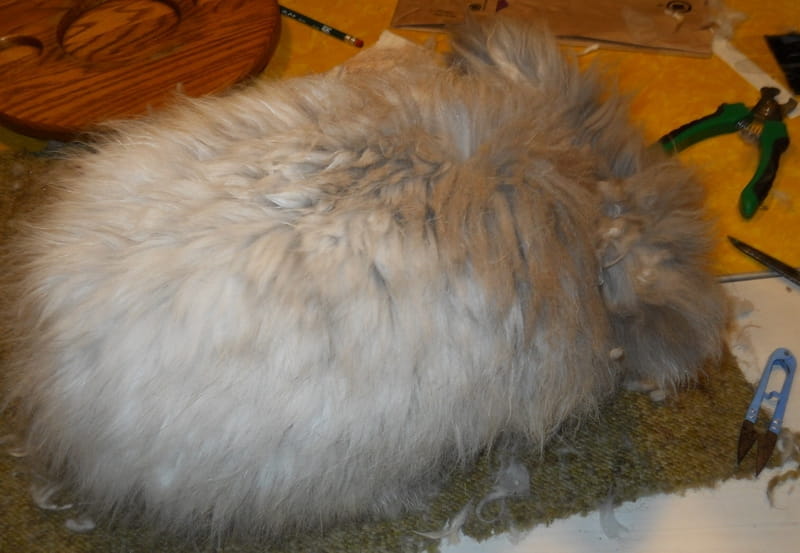
This Sydney before his haircut. He can still find food, but generally he finds it more by sniffing than seeing.
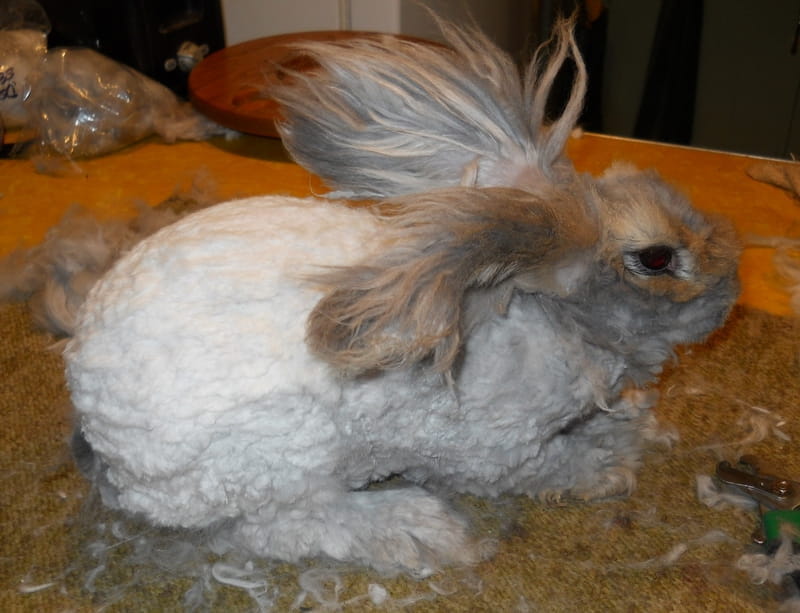
This Sydney after his haircut. He can see again! Yay! He will be all bouncy and 'binky' around after a haircut. A bunny 'binky' is a happy jump and twist for no reason at all except he's a happy bun.
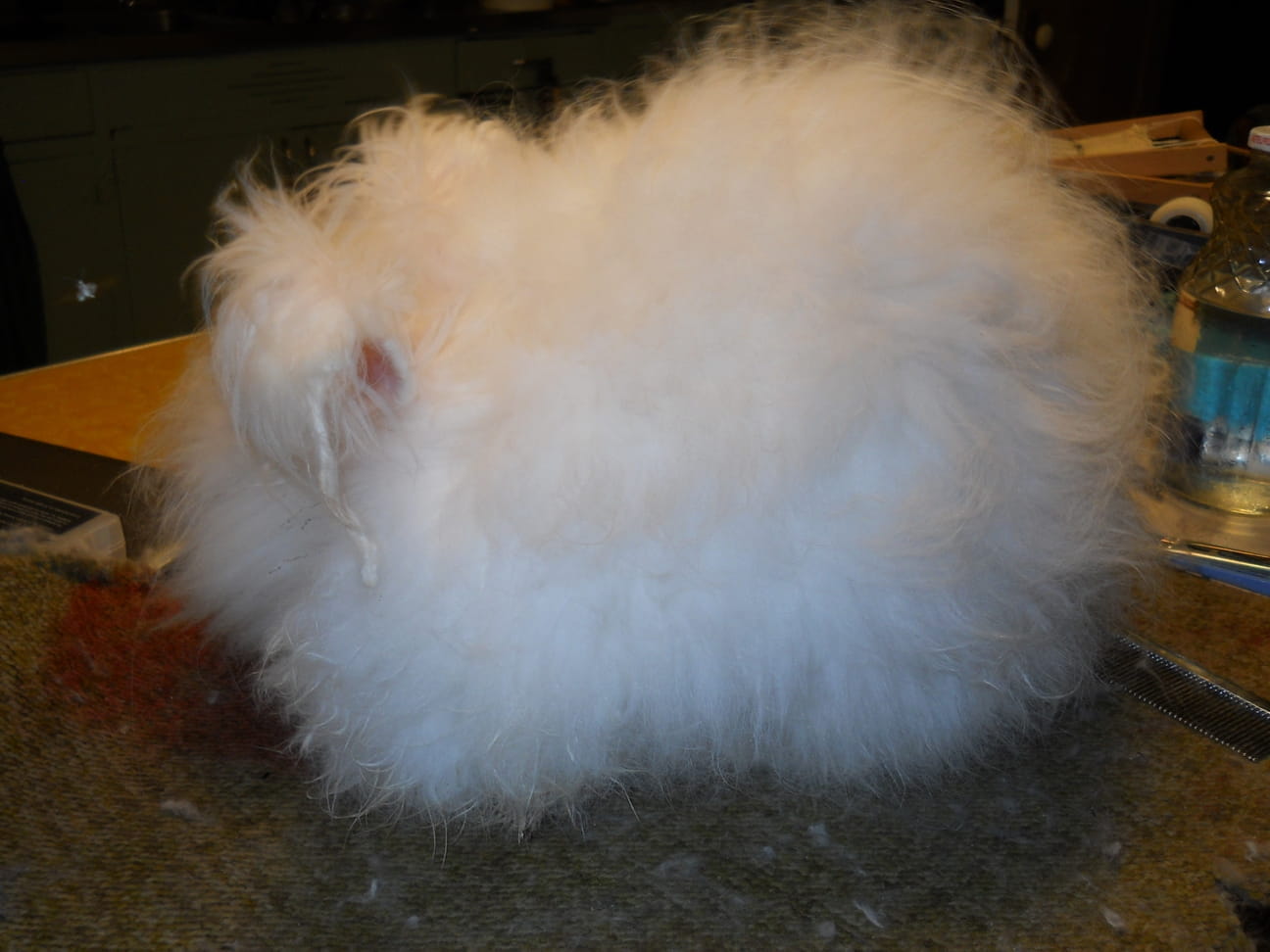
This Suzie before her haircut. She can still get fuzzier, but her coat is long enough to harvest.
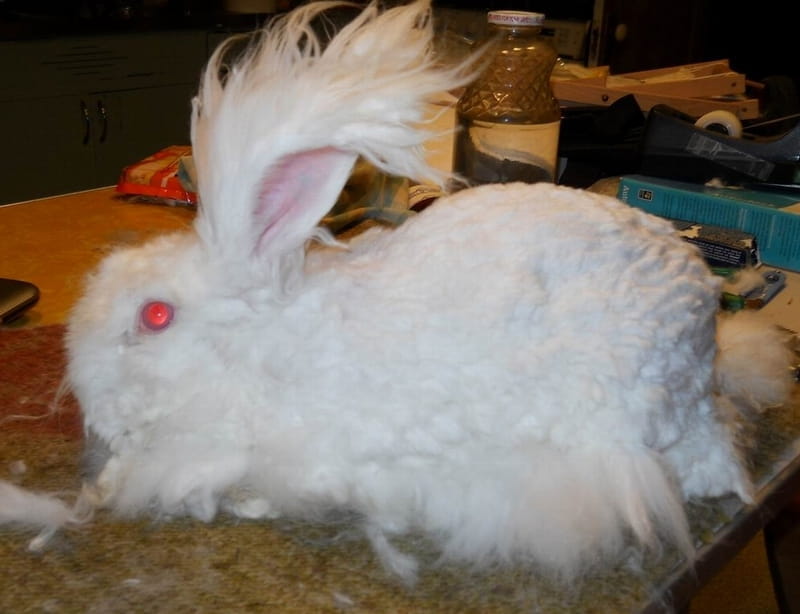
This Suzie after her haircut. Now she can see again and weighs a lot less, at least relatively speaking.
This is Sydney and Suzie before and after their haircuts. They always seems amazed to be able to see the world again after a haircut.
The English angora bunnies here at Hillside Farm get three or four haircuts a year so they get used to going from really fuzzy to looking half scalped. I'm not a very good bunny groomer as far as having a pretty bunny afterwards so they always look like they've been in some sort of natural disaster after a haircut. Since their fiber is being used to make Hula Bunny yarn, getting the fiber off in long useable lengths is more important than pretty bunnies afterwards. At least, I think so, I dunno about the bunnies' opinions. They do seem to get happy aferwards and bounce around although they soon settle down to the serious business of growing more wool again. They grow out their hair pretty quickly so they don't stay all higgly piggle looking for very long.
I'll try putting up a picture of each bunny and have that picture link to a page on them. That way you'll be able to see more than one picture of each bunny. Since there's way more bunnies than me, it may take awhile before they all get their bios put up. When it's all working, hopefully you'll be able to click on the picture of the bunny and then go to a page with more pictures and information about that particular bunny.
Since these are angora bunnies, we keep them for years and years. Their fiber is just as good when they're five or seven years old as it is when they're one year old. Other fiber critters will frequently have their best wool as their baby coat and fron then on, it gets less and less fine. The bunnies' baby coat is almost to the level of dryer lint and sometimes that will be sheared or plucked off and not saved.
Since we also breed for 'easy' care angora coats (even though we try for 'easy' there's still a lot of grooming involved), frequently we will let the baby coats grow out with very minimal grooming. At their first molt, we are then able to determine how (relatively) 'easy' care their coat will be. The ones who haven't made too many mats in their first coats is one of the selection criteria looked at to determine who will be kept as part of the breeding herd.
Angora fiber is very fine and soft, English angora fiber is the softest among the breeds of angora bunnies. It doesn't have much crimp to it, though, so yarn made entirely from angora fiber will have almost no stretch to it at all. Excellent for making scarves and shawls that don't need to cling, but not so good for fitted garments such as sweaters (which may be called 'jumpers' in Europe?) where you want the garment to cling to the body.
Angora is not good for socks. Other than the fiber being too delicate to handle being walked on, it also acts like a Swiffer and picks up every single particle of dust and dirt on the floor.
Hula Bunny yarn makes an interesting wash cloth. It has sort of a cling to it when the wet fibers are drawn over the skin. It may be nice for a face wash cloth, but I don't know if it would make a good general purpose wash cloth. I've only made one so far, probably won't make another since usually a scratchier texture works better to remove dirt and such.
I'm generally testing out Hula Bunny yarn to see what projects it works well with. If you find it especially good for certain projects, let me know. I may try wrist warmers next, I think Hula Bunny yarn would do well at that. I suppose, it's possible if one were just to pet a bunny all the time, they'd be great finger warmers. If there were kale and ti leaves involved, the bunnies would probably go along with this plan, too. And just think of all the spinning and knitting it would save to just use the bunnies for finger warmers?
If you like, you can send us an email and ask about bunnies, yarn, Hawaii things, what we should have on our webpage or just about anything else.
Mail to: Hillside Farm Hawaii
